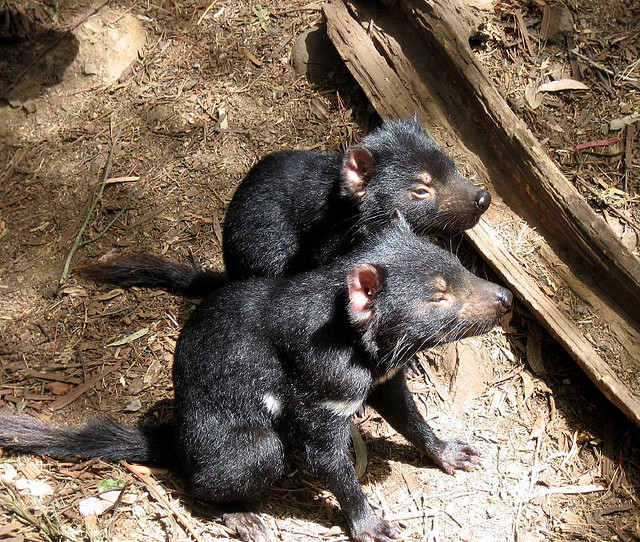In November 2013, a team of biologists scattered 15 plastic cylinders in the fields of Maria Island, three miles off the east coast of the Australian island state of Tasmania. Each cylinder contained a healthy Tasmanian devil, a marsupial species that until then lived only in Tasmania. Soon, the 15 devils emerged from the containers, becoming the first ever to inhabit Maria Island. The biologists were planning to take more devils to the island. Why? To establish a healthy colony, needed for the survival of the entire species.

Photo credit: Prince Roy, CC BY 2.0
The Tasmanian devil is on the brink of extinction because of an unusual disease — a contagious cancer that is spreading very quickly. In some areas, more than 90% of the population has been wiped out. The disease is called Devil Facial Tumor Disease, or DFTD for short, and is characterized by malignant tumors — around the mouth and head — that behave as parasites, and have caused an epidemic of cancer. The tumors are directly transmitted when the devils bite each other faces during fights — sometimes they bite off little pieces of tumor. When this happens, the cells reach the attacker’s bloodstream and, from there, its face. Once in the face, they start growing, producing a new tumor. Because the growth of tumors is not controlled by the devils’ immune system, the disease causes 100% mortality among infected devils.
Tasmanian devils (Sarcophilus harrisii) are dog-sized carnivorous marsupials known for their black color, spine-chilling screeches and bad temper — they look and sound fierce. Today, the devil is a Tasmanian icon set to disappear. However, if the devils become extinct in Tasmania, the disease will disappear with them, as they are the only animals affected by this type of contagious cancer. At that point, the healthy devils from Maria Island could be introduced back in the wild.
Carl Zimmer wrote that when the tumor disease was first discovered in 1996, many scientists assumed it was caused by a rapidly spreading virus. Instead, in 2006, Anne-Maree Pearse and Kate Swift (Department of Primary Industries, Water and Environment in Tasmania), discovered something strange about the tumor cells. The chromosomes looked less like those in the animal’s normal cells and more like those in the tumors growing in other Tasmanian devils.
Pearse and Swift proposed that the disease is transmitted when an infectious cell line is passed directly between the animals through bites they inflict on one another. They thought that the low genetic diversity and high degree of kinship among devils might help to reduce their immune response to cancer cells implanted during biting.
In 2007, Katherine Belov and her collaborators published a study showing that the tumor DNA was similar in different animals, but was different from the DNA present in the normal cells of the animal with the disease. This finding indicated that the cancer was contagious, spreading from one animal to another. The researchers wrote: “This novel disease arose as a direct result of loss of genetic diversity and the aggressive behavior of the host species. The neoplastic clone continues to spread through the population and, without active disease control by removal of affected animals and the isolation of disease-free animals, the Tasmanian devil faces extinction.”
Finally, in 2010, a team of Australian and American scientists confirmed that DFTD is a transmissible cancer. But why is this type of cancer not controlled by the immune system? Findings from a study published in 2013 show that DFTD cells do not express cell surface MHC molecules, which are a type of identity badge present in mammals. In absence of MHC molecules, the immune response directed to the cancer is very limited — the cancer cells “escape” and survive. The absence of MHC molecules is the result of down-regulation of genes essential to the antigen-processing pathway, such as β2-microglobulin and transporters associated with antigen processing, which all work together to allow killing of the cancer cells by specialized cells.
DFTD continues to spread through wild populations in Tasmania. However, there are now a total of 28 devils on Maria Island. In addition, The Tasmanian Devil Program has established a captive Insurance Population of Tasmanian devils in partnership with the Zoo and Aquarium Association. Over 600 healthy devils are being held in 36 zoos and wildlife parks across Australia, as well as five overseas zoos under the Tasmanian Devil Ambassador Program. Sadly, one of the devils under the program was killed in October by an unidentified individual at the Albuquerque Bio Park Zoo, New Mexico. The animal suffered a fractured skull and brain trauma caused by a block of asphalt.
On November 23, the Tasmanian Government and the Commonwealth Government announced the new Wild Devil Recovery Project. The project places greater emphasis on population monitoring, field research and testing of possible vaccines and immunization techniques to control DFTD. Indeed, field research to test a possible immunization strategy was announced on February 25, 2015.
This is an updated version of a post that first appeared December 5, 2014, on The Global Fool.